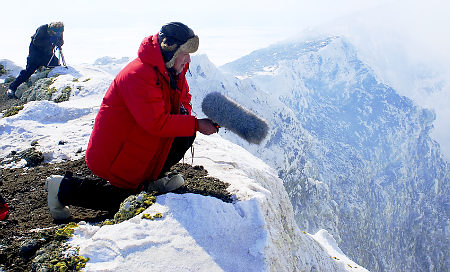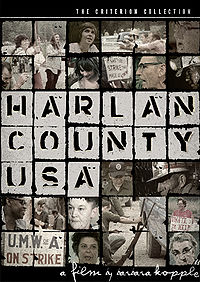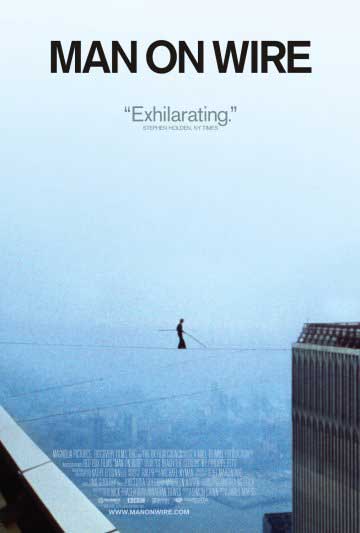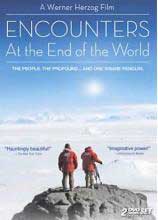
Soundless encounters
According to Marshall Curry, a great way to learn how to make documentary films is to watch them. Check. Then watch them again – with the sound off. I decided to give it a shot with Encounters at the End of the World, the Oscar-nominated film by Werner Herzog, that I watched yesterday. Conclusion: it’s work, but it works. Here’s what I picked up.
As a director, Herzog is enraptured by the beauty of the underwater world beneath the ice. He opens the film with that. This is a foreshadowing of the visual goodies we can expect to see if we stay with the film.
Herzog then switches to linear chronological storytelling: we see a big plane in the air, establishing that the filmmakers are on their way to make a film. Briefly he cuts to a shot of Lone Ranger riding his horse and footage of jungle ants milking sugar water from captured prey which, combined with his narration which I couldn’t hear, establishes his feelings about the journey, the questions he’s here to explore, and shares his perspective.
Then we see something often repeated in the film: a steady succession of storytelling shots which make use of different focal lengths and approach, but combine to establish what’s happening: 1. plane landing, medium shot. 2. plane taxiing into frame (closer shot). 3. plane taxiing away (wide shot).
Cut to historical footage. This allows more musing on the part of Herzog about what has gone before, and what is here today. Next shot is a fine example of a contrast cut: he cuts directly from shackleton’s team pushing sleds over ice ridges to close shot of the wheels of a giant “terra bus” used to ferry arrivals to McMurdo Station. This powerfully illustrates how far we’ve advanced since Shackleton’s time.
To get us into the first interview, he set up a tight shot of the stairs being lowered on the massive bus, from which the driver descends. Then we get into the first interview. It’s a nice visual bridge. It’s a “first step” into the story.
He uses a similar one-two edit on the next interview: 1. tight shot of caterpillar claw raking earth. 2. wide shot of caterpillar driver parking, dismounting, and walking over to the camera.
Interviews follow convention of positioning interviewer between key light and camera (most often the sun or window, although some scenes, even outdoor ones, appear to have been very subtly lit – but most are natural light throughout film).
Another 1-2 editing sequence: 1. Zoom out from ice cave (on sticks). 2. static shot of icicles inside cave.
Slow pan over McMurdo shows what the place looks like (and gives Herzog plenty of time to talk about his reaction to the place). There are many slow pans and zooms throughout the film, which does seem a bit amateurish – but presumably they were traveling light. It works.
In next interview, the detail of the scientists iceberg simulation is shot right off the screen, rather than captured in a quicktime file. This leads to one of the rare dissolve edits in the film (most are simple cuts) in which the simulation dissolves into one of the recurring visits to Shackleton historical footage – a shot of a man floating on a smallish chunk of ice while paddling furiously.
From there we have a brief interview with cook – showing off the McMurdo ice cream machine, which seems bizarre in such a climate. A lesser filmmaker wouldn’t have noticed the irony, and including this helps establish that some things really don’t make sense down here at the end of the world.
Another wide establishing shot of McMurdo, followed by slow zoom into city. One thing I noticed about the zooms is that they are always consistent speed – and the camera is usually on sticks when the zooming is happening.
The survival scene is priceless: it works visually as a metaphor for people blindly clawing their way around following each other despite having no idea where they are going. And it’s just plain funny. It’s all shot off shoulder, which, like most of the shoulder and handheld shots in the film, looks unsteady relative to what you’d expect in a film made by a filmmaker of Herzog’s calibre. I’m guessing the choice was deliberate, or at least a deliberate choice to live with the limitation so they could travel light and work fast. The camera work explores the subject in a lot of fairly lengthy cuts, complete with camera turns, approaches, and sweeping shoulder pans. The pans end crisply – no noticeable wobble. That takes practice. Nice mix of shots: detail shot of boots, bucket with face scrawled on it, contrasted with wide and medium shots of people.
From the simulated whiteout, we cut to a real whiteout – a nice transition to next sequence. This was some of the only whiteout footage that happened on the trip, though, and he gets back to nice weather with a nice scene of snowmobile overtaking another snowmobile, with camera pointed at nice, then you see that we’re on a snowmobile, then we overtake the one ahead, and now we stay abreast of it for second until the cut. For shots taking from a moving vehicle, it’s nice to shoot another moving vehicle that is moving a slightly slower or faster speed to give something interesting to look at and illustrate what’s going on.
Herzog’s cinematographer Peter Zeitlinger used very little shallow depth of field in this entire film (possibly because it was shot on an HDV camera which likely had 1/3″ sensors – at one point you can see what appears to be a prosumer video camera reflected in the sphere at the South Pole). Most of the interviews have a lot of background visible at beginning, then cut to a medium shot, and zoom in for emphasis at key points, or cut to tight shot. I noticed that on the medium and tight shots, the person was positioned close to center but just to one side. So he didn’t really follow convention of putting person clearly to one side or the other, and it works fine.
The scene where the scientists are listening to the ice is a great example of how he anticipated the edit, and then went out and got the best quality recording of seal sounds he could get (the Wikipedia entry for the film says it came from Douglas Quin, a sound expert.) But the visuals he pairs the incredible sounds with are really quite simple, and in fact, not well exposed (the faces are very dark). Herzog mentions what a bitch it was to shoot in the bright sun and ice, and I’m sure that’s true.
Another well-crafted transition: 1. Face of scientists pressed against ice listening to sci-fi seal sounds. 2. Cut to torch being ignited with a loud “pop.” 2. medium shot of him soldering pipe with torch. 3. cut to interview tight shot of face and hands. This is great way to get into the interview, and he uses it throughout the film as a way of introducing us quickly to the characters while moving the film along lyrically. For the interviews, when the camera is on sticks (about half the time) the camera operator stays on top of the action, and isn’t locked off – there is reframing.
Lots of helicopter footage bridges the sequences. Then wide establishing shot of hut where divers dive from. I mentioned the dive scene previously, so I’ll skip to this memorable scene after the dive, with the characters at rest in their hut watching a movie. This scene was obviously staged: the camera walks in slowly to the room, approaches one of the guys, then turns slowly, on cue to where they had set up the dvd, and then walks toward the small screen on which an old sci-fi film, “They,” was playing. Just at the moment the camera gets close to the screen and pauses, a nuclear flash detonates on the screen. And we hear horrible shrieks and drama with insects attacking people. It’s perfect match for Herzog’s narration.
One interesting technique: I noticed that in the interview with globe-traveling woman, he rolls on the hallway of her place for a good 10 seconds, before turning and walking slowly into her room, where she is painting. The next cut and we’re into the interview with her, of course. But the conscious decision to roll extra time at beginning of interview allowed Herzog to use that to set up the interview with his narration. I’m guessing he had his dp do that for all the interviews, and it’s a technique that I am going to adopt in interview situations to provide maximum flexibility in editing: roll 10 count BEFORE interview, and 10 count AFTER interview.
There are a ton of really WIDE shots in the interiors during the film. So much, that you see the world distorting when the camera pans – the straight lines are bent. It’s a little distracting, but clearly, this film was more about story and less about perfect cinematography.
From the interview with the guy who always has a pack ready to go (which includes a raft), he cuts to Shackleton’s ship pushing through icebergs. Interesting non-linear cut, because we’d already seen Shackleton’s ship founder on rocks in previous historical footage. But sets up next scene: we visit Shackleton’s camp, which is almost perfectly preserved by subsequent explorers and the cold air.
Next is a sequence dropped in (and lower film quality) of odd dude who aims to break weird records like walking with milk chocolate on his head, or doing most number of miles via summersault, in strange places like Antarctica. The whole sequence is created from archival footage – Herzog just needed the freakiest freak possible to carry the narration, and somehow got the footage to support it, and didn’t mind that it brought down the technical quality of the film. Archival footage you can get away with a lot, apparently.
The most memorable sequence in the film, with the sound ON, was this next one, of the penguin. Specifically, the one who wanders away from the pack to certain death. But I noticed with sound OFF, that it really doesn’t have near the arresting power as it did with the narration. In fact, it could have easily been camera angle trickery, it seems, so we trust Herzog to be telling it like it was. I was surprised just how much depended on his narration when I watched the same sequence without sound. Just goes to show that you can make good footage a LOT better with supporting sound and narration.
Another 1-2 cut: flying over volcano’s rim, to standing on the rim. This 1-2 editing works great to get us into the interviews. Herzog uses footage from the cameras to show eruption, as it wasn’t erupting when he was there, as well as dramatic footage of first explorers, who were injured by eruption while attempting to descend into it. His narration again makes the footage look MUCH more dramatic than it really is when you watch with sound off.
The shot of ice-covered machinery, and crashed helicopter (explored from several angles by camera) is great visual for narration.
The scenes shot under the pole in the dark tunnel are truly alien. Lighting them by using scientists flashlights to illuminate the objects – sturgeon, popcorn covered shrine, adds to otherworldly vibe.
I noticed two sections of the film fading to black and fading up, presumably indicating an act change or significant new part of film. And yet I didn’t feel like the film was really composed of acts.
One thing I wondered: did they film some of the helicopter stuff at 60p and then conform it to 24? That would probably help smooth out the shots, which do look slow mo in some cases. And explain why some of the helicopter footage is lower quality than the rest of film (assuming rest was shot at 1080p).
Another beautiful cut: After climbing around in fumaroles, there’s a wide shot of the snowy fumarole, and the camera tilts up slowly, until we see the sun filling the frame (which causes light to stop down, narrowing the size of the sun). Bang! We cut to big snow machine carrying a piece of aluminum that the sun is reflected in, which carries us forward into the next scene of the film – the helium-filled balloon launch, to study nutrinos – the films last sequence.
There’s the last interview with the handsome nutrino researcher who waxes philosophical about nature of existence, hinting that we’re coming to end of film. He describes an explosion at end of his interview and we cut to scene of the doors where balloon was stored opening to let sun shine in for one brief second – great edit. Then it’s over, fade to black.
Up comes three words in simple white Times font (which all text in film is set in): “For Roger Ebert.” I did some Googling, and it turns out that Roger Ebert has been a huge supporter of Werner Herzog, helping his films receive a wider audience than they might otherwise have achieved. In this open letter to Werner Herzog, Ebert says this, which is the highest form of praise any documentary filmmaker could hope for:
You have the audacity to believe that if you make a film about anything that interests you, it will interest us as well. And you have proven it.
 It’s doubtful that Harlan County, USA, is on any tourist guidebook “must visit” lists today. And it certainly wasn’t in 1973, when Barbara Koppel was making this classic social documentary about the struggles of striking coal miners. Just watching the footage, with its Southern drawl, red necks and decaying teeth made me want to move back to Canada. But I stayed in my chair. And I admire Koppel for staying in Harlan County for the years it took to make this important film, and glad she found gold under all that coal when she won an Academy Award when the film was released in 1976.
It’s doubtful that Harlan County, USA, is on any tourist guidebook “must visit” lists today. And it certainly wasn’t in 1973, when Barbara Koppel was making this classic social documentary about the struggles of striking coal miners. Just watching the footage, with its Southern drawl, red necks and decaying teeth made me want to move back to Canada. But I stayed in my chair. And I admire Koppel for staying in Harlan County for the years it took to make this important film, and glad she found gold under all that coal when she won an Academy Award when the film was released in 1976.





